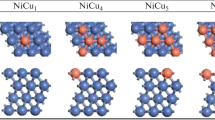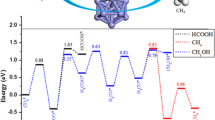Abstract
Understanding the carbon-tolerant mechanisms from a microscopic view is of special importance to develop proper anodes for solid oxide fuel cells. In this work, we employed density-functional theory calculations to study the CH4 reaction mechanism over a Ni/TiO2 nanostructure, which experimentally demonstrated good carbon tolerance. Six potential pathways for methane reforming reactions were studied over the Ni/TiO2(110) surface under both dry and wet atmospheres, and the main concerns were focused on the impact of TiO2 and Ni/TiO2 interface on CO/H2 formation. Our calculations suggest that the reaction between carbon and the interfacial lattice oxygen to form CO* is the dominant pathway for CH4 reforming under both dry and wet atmospheres, and intervention of steam directly to oxidize C* with its dissociated OH* group is less favorable in energy than that to wipe off oxygen vacancy to get ready for next C* oxidation. In all investigated paths, desorption of CO* is one of the most difficult steps. Fortunately, CO* desorption can be greatly promoted by the large heat released from the previous CO* formation process under wet atmosphere. H2O adsorption and dissociation over the TiO2 surface are found to be much easier than those over Ni, yttria stabilized zirconia (YSZ) and CeO2, which should be the key reason for the greatly depressed carbon deposition over Ni-TiO2 particles than traditional YSZ-Ni and CeO2-Ni anode. Our study presents the detailed CO* formation mechanism in CH4 reforming process over the Ni/TiO2 surface, which will benefit future research for exploring new carbon-tolerant solid oxide fuel cell anodes.
摘要
基于密度泛函理论(DFT)计算, 本文研究了Ni/TiO2(110)表面甲烷重整反应的机理, 揭示了固体氧化物燃料电池中TiO2基阳极较传统ZrO2或者CeO2基阳极材料具有良好抗积碳性能的重要原因. 本文对六种不同的甲烷重整反应路径(干燥和湿润的气氛环境)进行了详细研究, 阐明了TiO2, Ni/TiO2界面和水分子在甲烷重整反应中的作用以及Ni/TiO2基阳极抗积碳性能的来源. 经过计算发现, 在干燥和湿润的环境下, 碳原子和界面的TiO2晶格氧反应生成CO以及后续水分子吸附和解离在界面的氧空位上并提供反应所需O原子是甲烷重整反应的主要路径(C-O路径), 而水分子直接参与C原子或者CH基团的氧化反应则要困难很多. 值得注意的是, 在研究的六种反应路径中, CO从反应表面的脱附都非常困难, 需要约2.3 eV的能量才能使得其脱附. 因而造成大量表面反应活性位点被占据, 这是目前很多阳极材料不具备抗积碳性能的一个重要原因. 然而, 在湿润环境中, 水分子的吸附放热大大降低了整个反应体系所需能量, 尤其是本文中水分子在TiO2表面的快速解离吸附更是大大降低了整个反应体系的能量. 进一步研究发现, 水分子在Ni, YSZ和CeO2表面的吸附解离要比在TiO2表面困难很多. 这也是TiO2 基阳极材料具有较好抗积碳性能的一个重要原因. 本研究对于指导合成碳氢燃料气氛下具有优异抗积碳性能的固体氧化物燃料电池阳极材料具有重要的意义.
Similar content being viewed by others
References
Barreto L, Makihira A, Riahi K. The hydrogen economy in the 21st century: A sustainable development scenario. Int J Hydrogen Energy, 2003, 28: 267–284
Sehested J. Four challenges for nickel steam-reforming catalysts. Catal Today, 2006, 111: 103–110
Bengaard HS, Nørskov JK, Sehested J, et al. Steam reforming and graphite formation on Ni catalysts. J Catal, 2002, 209: 365–384
Besenbacher F, Chorkendorff I, Clausen BS, et al. Design of a surface alloy catalyst for steam reforming. Science, 1998, 279: 1913–1915
Lin Y, Zhan Z, Liu J, et al. Direct operation of solid oxide fuel cells with methane fuel. Solid State Ion, 2005, 176: 1827–1835
Park S, Vohs JM, Gorte RJ. Direct oxidation of hydrocarbons in a solid-oxide fuel cell. Nature, 2000, 404: 265–267
Jung S, Lu C, He H, et al. Influence of composition and Cu impregnation method on the performance of Cu/CeO2/YSZ SOFC anodes. J Power Sources, 2006, 154: 42–50
Tao, Irvine JTS. Catalytic properties of the perovskite oxide La0.75Sr0.25Cr0.5Fe0.5O3−δ in relation to its potential as a solid oxide fuel cell anode material. Chem Mater, 2004, 16: 4116–4121
Tao S, Irvine JTS. A redox-stable efficient anode for solid-oxide fuel cells. Nat Mater, 2003, 2: 320–323
Ma Q, Tietz F. Comparison of Y and La-substituted SrTiO3 as the anode materials for SOFCs. Solid State Ion, 2012, 225: 108–112
Marina O. Thermal, electrical, and electrocatalytical properties of lanthanum-doped strontium titanate. Solid State Ion, 2002, 149: 21–28
Suthirakun S, Ammal SC, Munoz-Garcia AB, et al. Theoretical investigation of H2 oxidation on the Sr2Fe1.5Mo0.5O6 (001) perovskite surface under anodic solid oxide fuel cell conditions. J Am Chem Soc, 2014, 136: 8374–8386
Liu Q, Dong X, Xiao G, et al. A novel electrode material for symmetrical SOFCs. Adv Mater, 2010, 22: 5478–5482
Yang C, Yang Z, Jin C, et al. Sulfur-tolerant redox-reversible anode material for direct hydrocarbon solid oxide fuel cells. Adv Mater, 2012, 24: 1439–1443
Chen XJ, Khor KA, Chan SH. Suppression of carbon deposition at CeO2-modified Ni/YSZ anodes in weakly humidified CH4 at 850°C. Electrochem Solid-State Lett, 2005, 8: A79
Yang L, Choi YM, Qin W, et al. Promotion of water-mediated carbon removal by nanostructured barium oxide/nickel interfaces in solid oxide fuel cells. Nat Commun, 2011, 2: 357
Zhan Z, Barnett SA. An octane-fueled solid oxide fuel cell. Science, 2005, 308: 844–847
Shinde VM, Madras G. Catalytic performance of highly dispersed Ni/TiO2 for dry and steam reforming of methane. RSC Adv, 2014, 4: 4817
Belhadi A, Trari M, Rabia C, et al. Methane steam reforming on supported nickel based catalysts. Effect of oxide ZrO2, LaO3 and nickel composition. Open J Phys Chem, 2013, 03: 89–96
Wang Z, Wang Z, Yang W, et al. Carbon-tolerant solid oxide fuel cells using NiTiO3 as an anode internal reforming layer. J Power Sources, 2014, 255: 404–409
Ling Y, Wang Z, Wang Z, et al. A robust carbon tolerant anode for solid oxide fuel cells. Sci China Mater, 2015, 58: 204–212
Burghgraef H, Jansen APJ, van Santen RA. Electronic structure calculations and dynamics of methane activation on nickel and cobalt. J Chem Phys, 1994, 101: 11012–11020
Watwe RM, Bengaard HS, Rostrup-Nielsen JR, et al. Theoretical studies of stability and reactivity of CHx species on Ni(111). J Catal, 2000, 189: 16–30
Jones G, Jakobsen J, Shim S, et al. First principles calculations and experimental insight into methane steam reforming over transition metal catalysts. J Catal, 2008, 259: 147–160
Au CT, Ng CF, Liao MS. Methane dissociation and syngas formation on Ru, Os, Rh, Ir, Pd, Pt, Cu, Ag, and Au: A theoretical study. J Catal, 1999, 185: 12–22
Zhang CJ, Hu P. Methane transformation to carbon and hydrogen on Pd(100): Pathways and energetics from density functional theory calculations. J Chem Phys, 2002, 116: 322
Huang ZQ, Long B, Chang CR. A theoretical study on the catalytic role of water in methanol steam reforming on PdZn(111). Catal Sci Technol, 2015, 5: 2935–2944
Ciobıcă IM, Frechard F, van Santen RA, et al. A theoretical study of CHx chemisorption on the Ru(0001) surface. Chem Phys Lett, 1999, 311: 185–192
Ciobica IM, van Santen RA. A DFT study of CHx chemisorption and transition states for C−H activation on the Ru(1120) surface. J Phys Chem B, 2002, 106: 6200–6205
Blochl PE. Projector augmented-wave method. Phys Rev B, 1994, 50: 17953–17979
Kresse G, Hafner J. Ab initio molecular dynamics for open-shell transition metals. Phys Rev B, 1993, 48: 13115–13118
Kresse G, Furthmuller J. Efficient iterative schemes for ab initio total-energy calculations using a plane-wave basis set. Phys Rev B, 1996, 54: 11169–11186
Perdew JP, Burke K, Ernzerhof M. Generalized gradient approximation made simple. Phys Rev Lett, 1996, 77: 3865–3868
Monkhorst HJ, Pack JD. Special points for brillouin-zone integrations. Phys Rev B, 1976, 13: 5188–5192
Henkelman G, Uberuaga BP, Jonsson H. A climbing image nudged elastic band method for finding saddle points and minimum energy paths. J Chem Phys, 2000, 113: 9901–9904
Tait RH, Kasowski RV. Ultraviolet photoemission and low-energyelectron diffraction studies of TiO2 (rutile) (001) and (110) surfaces. Phys Rev B, 1979, 20: 5178–5191
Ammal SC, Heyden A. Nature of Ptn/TiO2 (110) interface under water-gas shift reaction conditions: A constrained ab initio thermodynamics study. J Phys Chem C, 2011, 115: 19246–19259
Ammal SC, Heyden A. Origin of the unique activity of Pt/TiO2 catalysts for the water–gas shift reaction. J Catal, 2013, 306: 78–90
Ammal SC, Heyden A. Water–gas shift catalysis at corner atoms of Pt clusters in contact with a TiO2(110) support surface. ACS Catal, 2014, 4: 3654–3662
Li L, Zeng XC. Direct simulation evidence of generation of oxygen vacancies at the golden cage Au16 and TiO2 (110) interface for CO oxidation. J Am Chem Soc, 2014, 136: 15857–15860
Chou JP, Hsing CR, Wei CM, et al. Ab initio random structure search for 13-atom clusters of fcc elements. J Phys-Condens Matter, 2013, 25: 125305
Blaylock DW, Ogura T, Green WH, et al. Computational investigation of thermochemistry and kinetics of steam methane reforming on Ni(111) under realistic conditions. J Phys Chem C, 2009, 113: 4898–4908
Zhu YA, Chen D, Zhou XG, et al. DFT studies of dry reforming of methane on Ni catalyst. Catal Today, 2009, 148: 260–267
Blaylock DW, Zhu YA, Green WH. Computational investigation of the thermochemistry and kinetics of steam methane reforming over a multi-faceted nickel catalyst. Top Catal, 2011, 54: 828–844
Kho ET, Scott J, Amal R. Ni/TiO2 for low temperature steam reforming of methane. Chem Eng Sci, 2016, 140: 161–170
Rodriguez JA, Ma S, Liu P, et al. Activity of CeOx and TiOx nanoparticles grown on Au(111) in the water-gas shift reaction. Science, 2007, 318: 1757–1760
Hong S, Rahman TS. Rationale for the higher reactivity of interfacial sites in methanol decomposition on Au13/TiO2(110). J Am Chem Soc, 2013, 135: 7629–7635
Huang Y, Ling C, Jin M, et al. Water adsorption and dissociation on Ni surface: Effects of steps, dopants, coverage and self-aggregation. Phys Chem Chem Phys, 2013, 15: 17804–17817
Fronzi M, Piccinin S, Delley B, et al. Water adsorption on the stoichiometric and reduced CeO2(111) surface: A first-principles investigation. Phys Chem Chem Phys, 2009, 11: 9188–9199
Acknowledgements
This work was financially supported by the National Basic Research Program of China (2017YFA0402800 and 2016YFA0200602), the National Natural Science Foundation of China (51472228 and 21573204), the Fundamental Research Funds for the Central Universities (WK3430000004), and the One Hundred Person Project of CAS. The authors acknowledge the Supercomputing Center of the University of Science and Technology of China and the National Supercomputing Center in Tianjin for providing computational resources. Figures with geometry are based on the Jmol package (Jmol: an opensource Java viewer for chemical structures in 3D. http://www.jmol.org/).
Author information
Authors and Affiliations
Contributions
Author contributions Yang W designed and performed the calculations, analyzed the data, and wrote the paper; Wang Z helped build the computational models; Tan W made contributions to Fig. 9 in the manuscript; Peng R, Wu X and Lu Y conceived the framework of this paper and revised the paper. All authors contributed to the general discussion.
Corresponding authors
Ethics declarations
Conflict of interest The authors declare that they have no conflict of interest.
Additional information
Wenqiang Yang was born in Sichuan, China. He received his bachelor’s (2012) and master’s (2015) degrees in materials science from Nanjing University of Science and Technology and the University of Science and technology of China (USTC), respectively. He is now a PhD student at Andreas Heyden’s group at University of South Carolina. His current research focuses on computational heterogeneous catalysis and machine learning application on catalysis.
Ranran Peng received her PhD degree in materials science from the USTC in 2003. She currently is an associate professor in USTC. Her scientific interests include exploring novel electrode materials and revealing electrode reaction mechanisms for solid oxide fuel cells, and developing fantastic spintronic and multiferroic materials.
Yalin Lu was born in Jiangsu, China. He received his PhD from Nanjing University in 1991, and is now a full professor in USTC. Before joining USTC, he was a professor in AFA, Tufts University and Lawrence Berkeley National Laboratory. He currently serves as the Director of National Synchrotron Radiation Laboratory of China. His research focuses on quantum functional materials, nanophotonics, new energy materials and THz technologies.
Electronic supplementary material
40843_2019_1218_MOESM1_ESM.pdf
First principles study on methane reforming over Ni/TiO2(110) surface in solid oxide fuel cells under dry and wet atmospheres
Rights and permissions
About this article
Cite this article
Yang, W., Wang, Z., Tan, W. et al. First principles study on methane reforming over Ni/TiO2(110) surface in solid oxide fuel cells under dry and wet atmospheres. Sci. China Mater. 63, 364–374 (2020). https://doi.org/10.1007/s40843-019-1218-1
Received:
Accepted:
Published:
Issue Date:
DOI: https://doi.org/10.1007/s40843-019-1218-1




